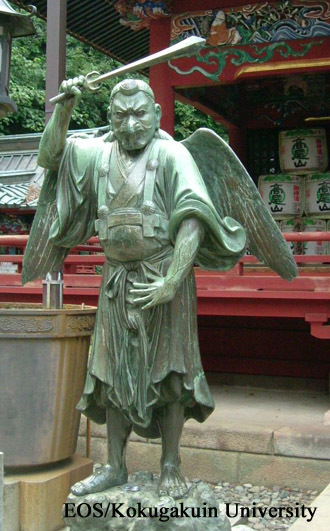- トップ
- Encyclopedia of Shinto
- Izuna Gongen
Encyclopedia of Shinto
| Main Menu: | |
| Links: |
詳細表示 (Complete Article)
| カテゴリー1: | 2. Kami (Deities) |
|---|---|
| カテゴリー2: | Combinatory Kami |
| Title | Izuna Gongen |
| Text | A kami worshiped by practitioners of the Izuna shugen cult. Also called Izuna Myōjin, this kami is enshrined in the Izuna Shrine at the summit of Mt. Izuna in the district of Kamiminochi, Nagano Prefecture. The Izuna cult first appears historically in the second part of the Kamakura-period work Asaba- shō (1279), where the name of Mount Izuna is seen in the legendary origins of the temple Togakushi-dera. Based on this entry, the cult is believed to have first spread among ascetic practitioners (shugen) at Togakushi. Later, however, the cult became increasingly independent in the form of Izuna shugen, and in the Muromachi period it was led by a famous pilgrim guide (sendatsu) named Sennichi Tayū. Iconographically, Izuna Gongen is usually depicted in a form resembling that of a tengu (a mythical winged demon with long nose believed to live deep in the mountains), and riding upon a white fox, a depiction resembling that of the deity Akiba Gongen (Sanshaku Gongen). Since Akiba Gongen is also believed to have originated in the Mt. Izuna and Togakushi area, the two deities are obviously closely related. Since the Buddhist counterpart (honji or "original essence"; see honji suijaku) of Izuna Gongen is said to be the bodhisattva Jizō (Sk. Ksitigarbha), the cult displays a mutual influence with the Atago cult (which involved an amalgamation with Shōgun Jizō or "Jizō of victory"). As a result, the deities are often referred to by the conjoined name Izuna-Atago. The Izuna cult also underwent combination from an early period with the cult of the Buddhist deity Dakini (Sk. Dakini), and a kind of magical technique was adopted from the medieval period involving the use of foxes as spirit familiars. This belief spread even among members of the court and warriors; the deputy shogun Hosokawa Masamoto (1466-1507) was known to have practiced the Izuna-Atago techniques (ref., Ashikaga kiseiki, Jūhen Ōninki), and the imperial regent Kujō Tanemichi (1509-1097) is likewise said to have studied Izuna practices (ref., Matsunaga Teitoku, Taionki). Such practices involving on the control of spirit familiars of foxes (kitsune tsukai) later came to be called izuna tsukai. The Izuna cult came to be associated with military arts as well, and Takeda Shingen and Uesugi Kenshin are known to have shown strong devotion to Izuna Gongen as a martial tutelary. The school of Japanese fencing called Shintō Munenryū is also said to have originated at Mt. Izuna. In addition to Mt. Izuna in Nagano, Izuna Gongen can be found enshrined at Yakuōin on Mt. Takao (in Hachiōji, Tokyo), Hinagadake in Gifu, and Mt. Izuna in Sendai. The Izuna Gongen of Sendai goes by the name Izuna Saburō, and is particularly well known as one of the "three tengū of Japan." Some scholars have suggested that belief in this tengu was responsible for the Izuna cult. -Itō Satoshi |




